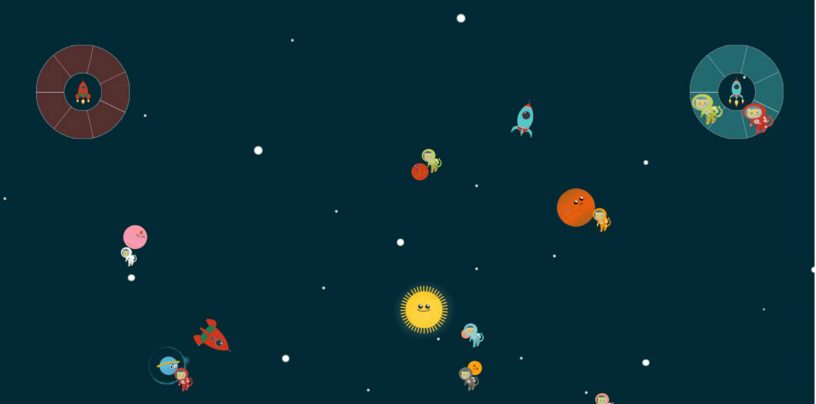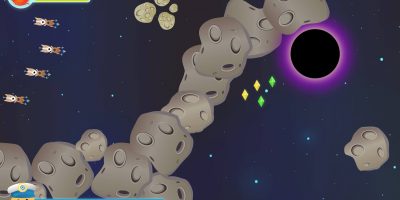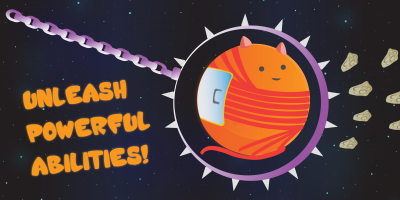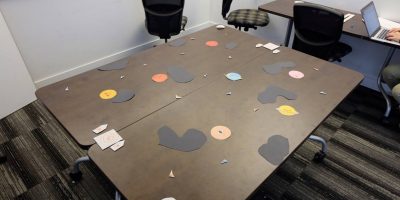GraviTeam was asked to create an interactive exhibit as part of the CDM’s Space Lab in September 2016.
CORE CONCEPT
An exhibit featuring an immersive cave installation, as the setting forCatronauts, a 2-4 player computer game. Catronauts teaches kids about gravity, propulsion, and planetary positions as they race to rescue catronauts and return them to Earth.
DESIGN AIMS
The central challenge was to provide a shared experience that educates children about basic principles of physics in space, and the order of the planets. The placement of our exhibit is towards the end of the museum’s user flow, by which point visitors may feel tired and inundated with information and stimulus. Thus, we consider it key that our exhibit be short, accessible and fun.
Through gameplay, we are able to transform the learning process into active learning rather than passive consumption. With multiplayer functionality, we offer an experience that can be shared by families. The exhibit is designed to feel immersive, yet intimate enough to give the feeling of a couch game.
Above all, we aim to make the experience one that is fun and friendly, rather than dull and intimidating. This notion drove our creation of playful catronaut characters, the anthropomorphic planets, and the humorous characterization of the sun.
TARGET AUDIENCE
The target audience is, primarily, kids between the ages of 6-12 years old (particularly children over 10 years old), and secondarily, museum goers of all ages. We expect the kids to reflect the diversity of the community, and anticipate that English will not be the first language of many of our players. For six-year old children on the low end of our age spectrum, they will just be learning to read in the first grade. This informed our choice to make the game as accessible as possible, and try to make the display as visual as possible, rather than relying on text.
PERSONAS
Ellie: Ellie is a child, 6 years old, who is a novice to games. She has played children’s games on her mobile devices, but has never used a controller. She recently started the First Grade, and is learning to read. She lives in Mount Pleasant with her parents–a lawyer and a teacher–and her 2 year old sister Alice. Her weekends are filled with recreational, and her father has brought Ellie and her sister Alice to the Space Museum as a learning and recreational activity.
Duncan: Duncan is a 37 year old man, who teaches creative writing at UBC. He has two young children, ages 10 and 6, and lives with his family in Burnaby. He has a masters degree, and his income is $70K per year. He casually plays games on his mobile devices like Candy Crush and played video games on the Sega Genesis and Super Nintendo as a child. He has brought his kids to the Space Lab on the weekend.
Zach: Zach is a 26 year old graduate student, studying computer science at SFU. Zach is a self proclaimed “nerd”, expert gamer, and science fiction aficionado. Zach came to the Science Lab with a group of like-minded friends to learn more about interactive design, space, and to have fun with friends.
These personas give us a cross section of the museum’s target demographics of children, adults (parents and teachers attending with children), and young adults. The aim of our testing was to ensure that the game was accessible, attractive, and fun for all ages and all levels of gaming experience.
GAME OVERVIEW
At the outset of the game, each player is represented as a spaceship in a corner of the solar system. The object of the game is to be the first to rescue the all catronauts, one by one, and return them to earth. The Heads-Up Display (HUD) allows players to monitor their progress in collecting the catronauts, and compare it to their competitors.
Each of the planets features a gravitational pull relative to their mass. Since the sun’s mass is greatest, it has strongest gravitational pull. Skilled players utilize gravity to facilitate movement: to allow themselves to be drawn into a planet’s orbit when it has an uncollected cat.
In Catronauts, players die when they fall into the sun, collide with other players, or move beyond the outer edges of the display screen. Death causes the player to lose any item they were holding and returns them to their starting position. As we discovered through testing a 2 player prototype, collisions are both a key source of fun and a strategically resource. We noted that when one player was about to win, their opponent would attempt to crash into them and cause them to drop their item. In other instances, players would be so wrapped in play that they would not see the other ship until gravity or speed made the collision inevitable. Both players frequently laughed in response. Player’s enjoyment of conflict, as well as our desire to engage more users at a time, caused us to prioritize 4 player functionality. User testing indicates the game is most fun with 4 players.




Leave a Reply